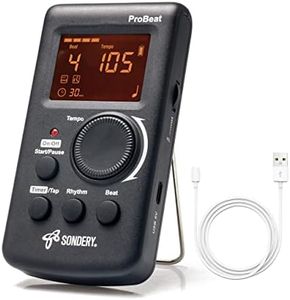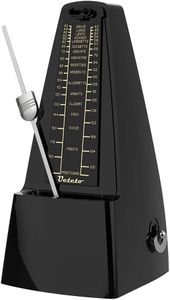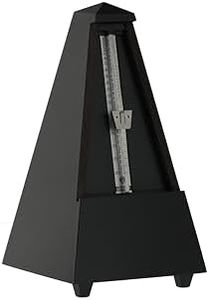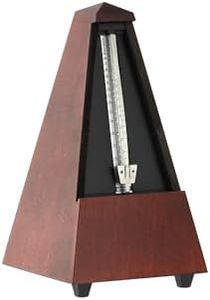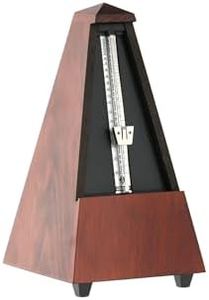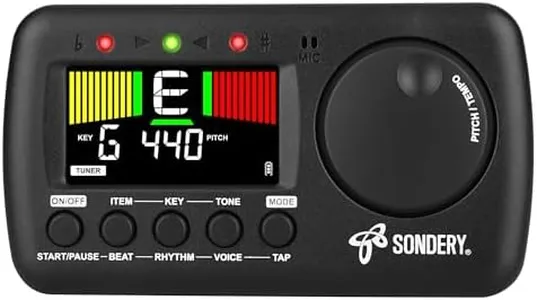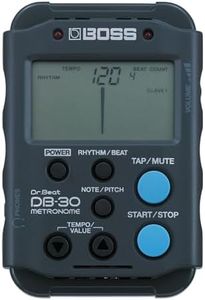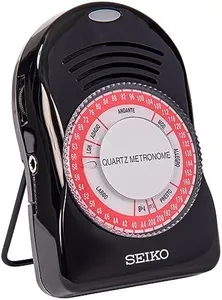Top 10 Metronomes Deals Right Now
Editor’s Choice
Sondery Digital Metronome Rechargeable English Vocal Counting with Timer Function for Piano Guitar Drum and All Instruments
Our technology thoroughly searches through the online shopping world, reviewing hundreds of sites. We then process and analyze this information, updating in real-time to bring you the latest top-rated products. This way, you always get the best and most current options available.

Our Top Picks
Sondery Digital Metronome Rechargeable English Vocal Counting with Timer Function for Piano Guitar Drum and All Instruments
Most important from
1810 reviews
The Sondery Digital Metronome offers a wide tempo range from 40 to 208 bpm, catering to most musical needs. It includes three sound options and vocal counting, which can be particularly useful for beginners who need clear audio guidance. The metronome also features volume control through a loud speaker, ensuring it can be heard during practice, and it includes an earphone jack for quiet sessions, making it versatile for different environments.
Visual indicators like the LED light provide an additional cue to help keep time, which is useful for practicing in noisy settings or during live performance. The metronome supports multiple rhythm patterns, allowing for diverse rhythm training. Portability is well addressed with its small size and light weight, making it easy to carry around. Rechargeable via USB, it eliminates the need for frequent battery replacements, which is convenient.
Additional features like a timer function and tap tempo enable customized practice sessions and ease of use. However, the plastic build might not feel as premium, and users who prefer tactile feedback might find the buttons and knobs less satisfying compared to traditional metronomes. Also, while the vocal counting is a great feature, it might not be indispensable for advanced users. The Sondery Digital Metronome is an excellent tool for musicians who need a reliable, portable, and versatile metronome with modern features.
Most important from
1810 reviews
Great Choice
Ueteto Mechanical Metronome Black/Loud Sound Piano Drum Violin Guitar
Most important from
2145 reviews
The Ueteto Mechanical Metronome is a classic wind-up device designed to help musicians keep a steady tempo while practicing various instruments like piano, guitar, violin, and drums. Its tempo range of 40 to 208 beats per minute covers most musical needs, and it offers beat selections including 2, 3, 4, and 6 beats per measure, which adds flexibility for different rhythms. One of its strengths is that it requires no batteries, running on a mechanical wind-up mechanism that lasts about 18 minutes per full wind, which is convenient and eco-friendly. The metronome produces a loud, clear click and bell sound, making it easy to hear during practice sessions.
Its design is relatively portable at just over a pound and compact size, so it's easy to carry around or fit on a music stand. Visual indicators like the swinging pendulum help users follow the beat visually, which is helpful especially for beginners or children. However, being purely mechanical means it doesn’t offer volume control or a variety of sound options like digital metronomes do. Also, while it’s durable and simple to operate, some users may find setting the tempo less precise compared to digital alternatives.
This metronome represents a solid choice for musicians looking for a reliable, traditional, and battery-free tool to develop rhythm and timing skills without extra digital features.
Most important from
2145 reviews
Wittner Wood Case Black Metronome with Bell Tuner (816M)
Most important from
78 reviews
The Wittner Wood Case Black Metronome with Bell Tuner (model 816M) is a solid choice for musicians seeking an elegant and functional metronome. With a classic wooden case and a design that pays homage to traditional metronome styles, it appeals to both novice and experienced musicians. One of its strengths is the tempo range, which allows adjustments to suit various musical pieces, making it versatile for different genres. The built-in bell feature provides a clear auditory cue, enhancing timing accuracy, especially for those learning complex rhythms.
In terms of sound options, this metronome offers a pleasing tone that is neither too harsh nor too soft, making practice sessions enjoyable. Volume control is a valuable feature that helps tailor the sound to different environments—whether at home, in a practice room, or even during a lesson.
Visual indicators on the Wittner metronome are helpful for those who prefer to synchronize visually as well as audibly. Its portability is another plus, as it can easily fit into a music bag, allowing musicians to take it along to rehearsals or performances.
There are a few drawbacks worth noting. The product's rhythm patterns are somewhat limited, which might not satisfy advanced users looking for more complex time signatures. Some users may also find that the metronome’s weight, while giving it a sturdy feel, makes it less convenient for those who prioritize ultra-light gear. This metronome is an excellent choice for those appreciating a traditional style and simplicity in their practice routine, but it may fall short for users seeking modern features.
